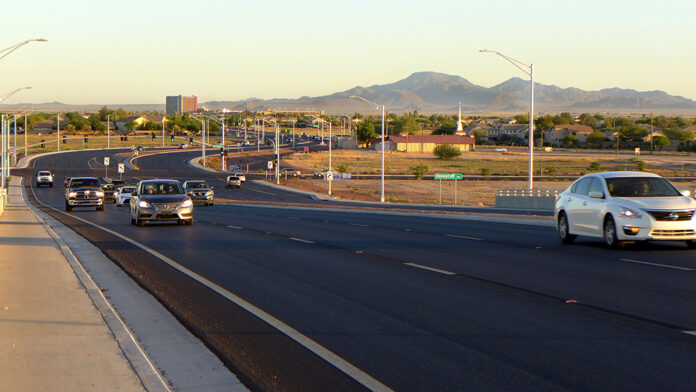
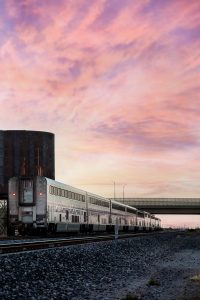
By Bob McGovern and Kyle Norby
For years, the train tracks passing through town were the go-to excuse for many Maricopa students looking to delay the start of their school day.
But the much-anticipated overpass has changed life in the city in numerous, more substantive ways, too. Its impact has been immediate, and even more positive effects will play out over years, if not decades.
Motorists perhaps have benefited the most from the bridge over the tracks, which opened to traffic on July 15, 2019. The elimination of the train crossing immediately made it safer for motorists and reduced traffic congestion and related stress.
Residents living south of those tracks have seen huge benefits from the overpass as well, and perhaps stand to gain the most from the overpass in the long-term.
Bridge bypassed the tracks – and some businesses, too
$55 million project spurs commercial, residential development
Ambulances respond to health emergencies faster, firefighters can answer fire calls, and police can more easily get to developments like Maricopa Meadows, Alterra, Desert Cedars, Palo Brea and Santa Rosa Springs, according to city officials.
The 500-foot-long, $55 million overpass, has opened multiple avenues of development, with builders putting up (and planning more) homes in Palo Brea and Alterra. Commercial development along John Wayne Parkway is increasing as well.
Businesses in the south end of town have benefited as well, with customers and employees finding it easier to get to and from Harrah’s Ak-Chin Hotel and Casino and the UltraStar Multi-tainment Center.
“I had always said that when the overpass goes in, not only is it going to help protect us from a public safety standpoint, because we simply don’t have the interaction with the trains anymore,” Mayor Christian Price said, “but the bigger thing – the long-term thing – will be the fact that it opens up the city in a way that we had never experienced before. Because we really did have a north and south side of the tracks.
“It’s kind of the gift that keeps on giving.”
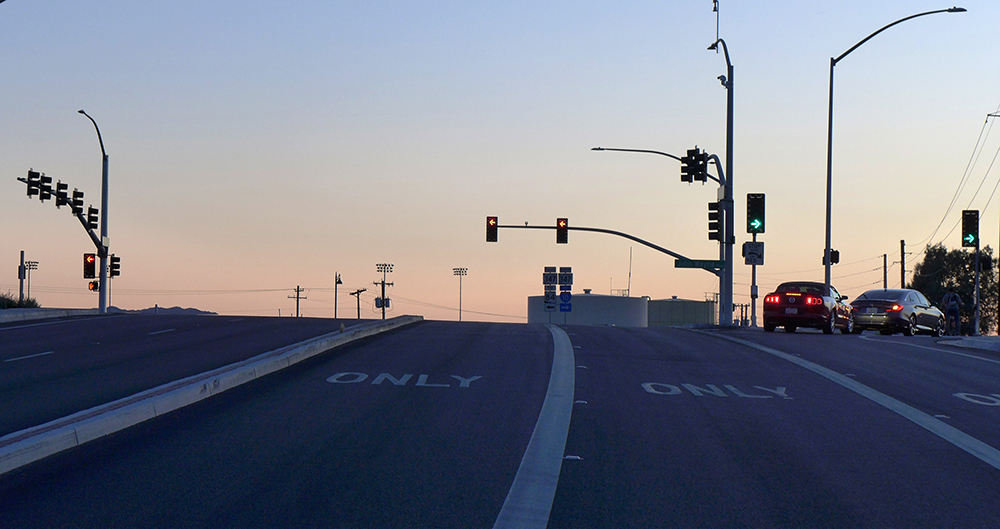
A COLLECTIVE PATIENCE WORN THIN
As the city of Maricopa rose quickly on this nearly 43-square-mile patch in the desert, it grew around the Union Pacific Railroad tracks that bisect the city. The vast majority of that land lies south of the tracks.
The rail line intersected with State Route 347, the city’s main transportation corridor, which carries more than 31,000 vehicles per day on average and is expected to reach 60,000 vehicles per day in 2040, according to the Arizona Department of Transportation.
Crossing the tracks at SR347 was a major headache as often as not, especially during rush-hour. Lights would blink and the safety gates would fall about 60 times a day as UP freight trains traveled the Sunset Route rails east and west laden with ferrous scrap, wheat and flour, and assembled vehicles.
It was a longer wait if you were trying to cross the tracks while Amtrak’s Sunset Limited train was in the Maricopa station, just south of the crossing. Motorists could wait 20 minutes or much longer as passengers – and their luggage – embarked and debarked one car at a time, the train edging forward so the process could be repeated on successive coaches.
Many drivers found the situation excruciating, honking their horns at the train. Motorists regularly would turn their cars around. Others would turn off John Wayne Parkway and make long detours around the crossing if they saw the gleaming silver railcars in station.
Judit Kalman Hutson doesn’t miss the old crossing one bit. She moved from Desert Cedars to The Villages at Rancho El Dorado in 2011, in part to minimize its effect on her daily life.
A Maricopa resident since 2005, she recalls getting “cut by the train” on her way to work from Desert Cedars or leaving her home at 10:20 p.m. and not making it to Fry’s before the doors closed at 11.
After she moved, three times a day she would leave 30 minutes early to make the 2.5-mile-or-so drive from The Villages to Copper Sky for her kids’ morning swim practice or her evening spin class. The same trip today takes maybe 5-7 minutes, said Hutson, 44.
“I believe the majority of the residents agree that the overpass has been a positive result for our community,” she wrote on Facebook. “We can’t satisfy everyone for sure, but I believe we came pretty close with this one.”
“I love the overpass.”
Similar stories are numerous.
Bri Wilson, 25, recalled the hassle of leaving from her bartending job at UltraStar at night just to be caught waiting at the tracks.
“When I worked on Sunday nights, I’d either get stuck for around 30 minutes and I’d have to decide whether it was worth it to just wait it out or go all the way back down over by Porter Road to get through,” she said.
Beth Mundell, who lives in Maricopa Meadows, said she would routinely get stuck at the crossing for 30-45 minutes.
“I’d think there had to be a science” to avoiding the Amtrak trains, she said. Then, about a year after she moved here, someone told her about the Amtrak app. She downloaded it and would literally schedule her leaving and return to the house around when the app indicated the train would be in station, she said.
“The overpass was life-changing in a lot of ways,” said Mundell, 45, a 12-year resident of the city. “I don’t even think about it anymore. I don’t think about the train. I haven’t even looked to see when it’s coming or going since the overpass opened.”
The first time she used the overpass she remembers thinking, “’Thank goodness that this is here.’ I know the city council and the mayor worked so hard for it.”
For years, the crossing wore on the collective patience of the city. Heading from one end of town to the other was a mental hurdle. Everybody knew the solution, but where would the money come from?
‘IT WAS THE GREATEST THING’
City leaders envisioned an overpass – or underpass – way back in 2004.
The town was already booming. The population had mushroomed from about 1,000 residents to about 7,000 in just four years and was growing by about 1,000 residents a month by that year.
The city council’s general plan, a blueprint for what Maricopa would become over the next 10-15 years, included a Capital Improvement Plan with at least one costly project – a way over or under the tracks.
By 2013, through the persistence of city leaders, including former Mayor Kelly Anderson, the much-needed project was firmly on the radar of state officials and leaders in Washington.
At the time, Price said a “proactive” effort on behalf of the city and other interested parties helped push the project to the top of priority lists, according to an InMaricopa.com report. The city’s lobbying firm, Nexxus Consulting, helped open doors in Washington.
Robert Miguel, chairman of the Ak-Chin Indian Community, recalled pushing the project in the nation’s capital when he was there to promote his community.
“Every time I’d gone to D.C. myself representing Ak-Chin Community … I always made it a priority to sneak in a couple of quotes and try to establish a relationship with these lawmakers. ‘You know, we need this overpass in Maricopa, so if there is any way we can influence and persuade to award Maricopa that grant, we’re here to do that,’” he said.
“All we wanted was to make sure the residents of Ak-Chin and Maricopa were protected, public safety-wise, and for smoother flow in traffic,” he added. “When it happened, it was great to see. It was the greatest thing to see that overpass go over.”
Ak-Chin did not contribute to the project. However, it was eventually funded by a $15 million federal TIGER grant and a $15 million contribution by the City of Maricopa, in addition to ADOT’s $19 million commitment.
Rick Horst, the current city manager, observed the project was a long time in the making and noted the contributions of past council members and city leaders in getting the overpass constructed.
“They deserve a lot of credit,” he said.
DOUBLE THE DANGER
City leaders and residents waited a long time for a remedy.
The rail crossing at John Wayne Parkway, with its high traffic counts (trains and vehicles) and many accidents, was dangerous. Everybody knew it. In fact, a letter included with a city application for a federal grant in May 2013 to help address the safety problems called it “one of the most dangerous rail crossings in Arizona.”
“Because it bisects the fastest growing area of Arizona, traffic is congested, public safety is compromised, and children are at risk because of its proximity to a high school,” read the letter to the secretary of the U.S. Department of Transportation.
People died.
In June 2000, a child died after becoming trapped in a truck that stalled on the tracks.
A motorcycle rider was killed at the crossing in February 2013 after striking a descending barricade arm.
Other lives were threatened, too, like the young school bus driver who escaped injury in November 2015 by leaping off a bus, empty of kids, that was stuck on the tracks before it was struck by a freight train.
The intersection of John Wayne Parkway and Honeycutt Road, 600 feet north of the tracks, was dangerous, too. Too many motorists heading west on Honeycutt would make illegal left-hand turns onto John Wayne leading to many wrecks.
“The intersection at Honeycutt and 347 was our top crash or collision intersection for three or four years running,” said Maricopa Police Chief Steve Stahl, because drivers violated the no left-turn sign.
“And it was a one-way road where, you know, people became too impatient because the roadway was backed up,” he said. “So, it was an extreme situation.”
The overpass, an Arizona Department of Transportation project, did two things to dramatically improve safety. The bridge took the heavy traffic over the tracks, eliminating interaction between trains and vehicles, and the long waits commonplace for decades. It also realigned John Wayne to the east, its intersection with Honeycutt Road redesigned to make it easier to navigate safely and enhance traffic flow.
The John Wayne-Honeycutt intersection is “by far safer” today, Stahl noted. “Now, we’re rarely called there for a crash.”
“The safety and mobility benefits of this improvement occur each time a train passes State Route 347,” said Steve Elliott, Arizona Department of Transportation. “ADOT and Maricopa worked closely together to make this improvement a reality, and the result has paid dividends for the past year and will continue benefiting the city for decades to come.”
Union Pacific supports roadway grade separations as they have broad public benefits, said spokesman Tim S. McMahan.
“(The overpass) improves traffic flow for the thousands of vehicles who previously were required to stop if a train was present at the crossing and eliminates potential collisions that could occur at an at-grade crossing, both with motorists and pedestrians,” he said. “We applaud the efforts of those involved in making this a successful project.”
“We consider this project a success and look forward to working with the community on the next opportunity.”
TIME-WORN EXCUSE LEAVES THE STATION
The gleaming white overpass ended a longtime excuse for students late to class at Maricopa High School.
Tori Kaszubski, 23, a 2014 graduate of MHS, remembers vividly being trapped by the dreaded Amtrak trains.
“I remember the bus being stuck at the railroad crossing for as long as an hour sometimes,” Kaszubski said. “I think a good handful of us started to realize we could use the Amtrak to our benefit, since we would be late taking the bus anyway, why not ditch and walk to get breakfast knowing we’ll be excused because of the traffic?”
Another graduate, Nicolas Kalnasy, 25, laughed and said, “It was an absolute annoyance. I am glad they built a bridge and got over it.”
Maricopa Unified School District fought an uphill with the tracks for years, from bus delays to the inconvenience of sporting events letting out during late-night Amtrak stops. Serfio Pulido, transportation director for the district, said the overpass has been a marked improvement for transportation routes and getting kids to first period on time.
“The overpass is a blessing when it came to route timing. I’ve had nothing but positive feedback,” Pulido said.
This story appears in the July issue of InMaricopa.

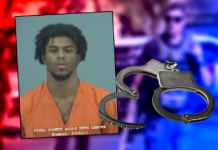
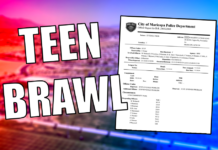


![Elena Trails releases home renderings An image of one of 56 elevation renderings submitted to Maricopa's planning department for the Elena Trails subdivison. The developer plans to construct 14 different floor plans, with four elevation styles per plan. [City of Maricopa]](https://www.inmaricopa.com/wp-content/uploads/2024/04/city-041724-elena-trails-rendering-218x150.jpg)

![Affordable apartments planned near ‘Restaurant Row’ A blue square highlights the area of the proposed affordable housing development and "Restaurant Row" sitting south of city hall and the Maricopa Police Department. Preliminary architectural drawings were not yet available. [City of Maricopa]](https://www.inmaricopa.com/wp-content/uploads/2024/04/041724-affordable-housing-project-restaurant-row-218x150.jpg)









